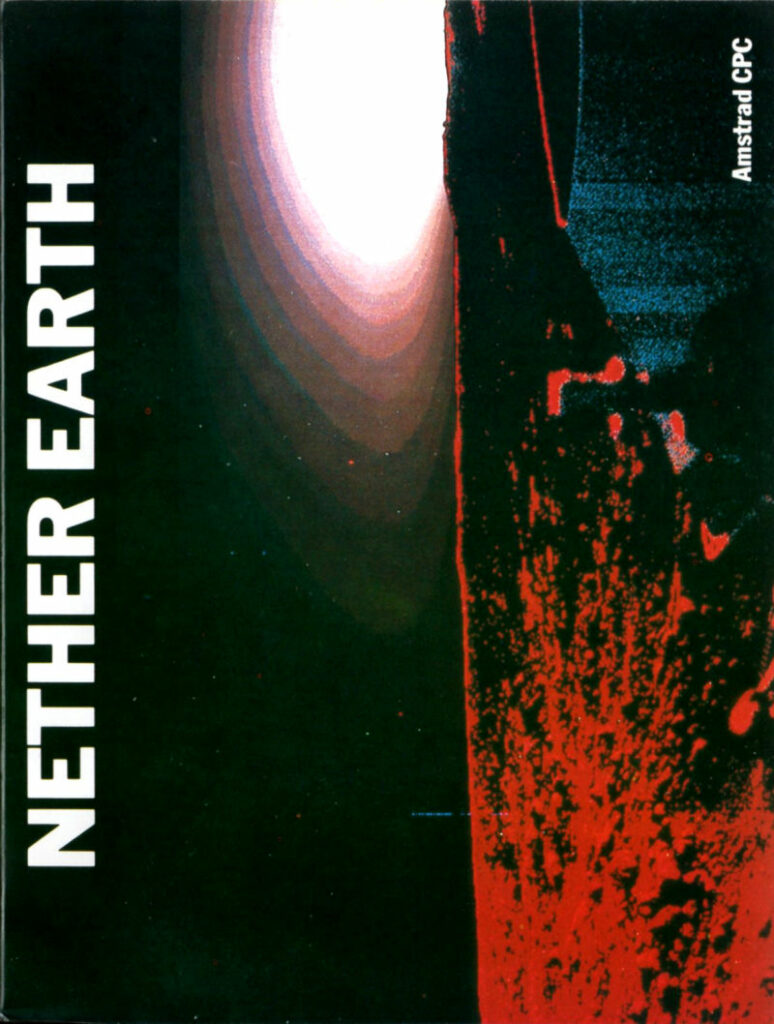Nether Earth Review

Wipe out the invading scum in this proto-RTS game… Feel the full aspect of this mechanized conflict between Earth and the Insignian forces… The last stand…
STORY
So that’s what these alien invaders are known as… The “Insignians”… They have never shown themselves, but when they one day appeared on Earth in their ridiculously well-oiled war machine, they swiftly proceeded to take over and effectively destroy all potential resistance. Ages passed and the Insignians always had more powerful armed forces than the humans. (Which the sixteen previous human lead offensives throughout history disgracefully showed.)
And the Insignians have always been hiding in their machines… But eventually, luck turned, and Captain Fergus McCafferty and his unit managed to capture an Insignian war base. The base is now known as Kerberus.
I don’t know if you jinx shit by sort of naming a base after a three-headed dog guarding the exit from Hades, but nevertheless – Hope returns, and so on…
THE GAME
You might have “already” guessed that the main mission in Nether Earth is to annihilate the Insignians while trying to keep the war going until the last drop of blood. Or at least until Earth has won. (Or lost.)
The Kerberus base is the starting point of this operation and it’s located at the far left end of the diagonally scrolling map. The map is displayed in isometric perspective and is eight blocks “high” (Which represents 16 miles in the game.) and 256 blocks wide. (That would be 512 miles.) Three Insignian bases have to be destroyed – The first, Tarras, is 208 miles away. The second one, Faretra, is 316 miles away. And then, you have Diolkos on the other side of the map.
CONTENT
Because it looks bleak on Day 1…! You control a module that moves in four directions as well as up and down. On screen, you follow the module unit across the map. (The gameplay area.) Beneath the gameplay area is a side-“scrolling” radar. A clock in the top right corner keeps track of the time and for how many days the offensive has lasted. (The days go by very fast in Nether Earth as you can move the module about 16 miles every real second.)
And then, there are the stats for both sides, i.e., how many war bases you have under your control, including the resources available – Electronic support modules, Nuclear weapons, Phasers, Missiles, Cannons, Chassis, and Robots.
The module is basically used for reconnaissance, controlling your units, and managing your resources. Landing on the Heli-pad of a factory and pressing the Fire-button brings up the “Robot Construction” screen. This screen shows how much resources you have access to and what kind of a robot or robots you’re building. You begin with a chassis before applying one, two, or three weapon modules to it. There are three different types of chassis with their own advantages and disadvantages – Bipod, Tracked, and Anti-Grav. While the Bipod is good for ground level operations, the Anti-Grav type can fly. But on the other hand, it’s more vulnerable. Electronic modules grant either better firepower or damage resistance.
Just like your control / reconnaissance module, the robots are big as houses. The same relation between scale and distance applies in the game. (An hour flies by in three actual seconds.) So the robots move several miles in just a few moments. (The battles are almost just as fast.)
Landing the module on a unit brings up another menu with the following options: Direct Control, Give Orders, Combat Mode, and Leave Robot. Possible orders are: Stop & Defend, Advance [a number of] Miles, Retreat [a number of] Miles, Search & Capture, and Search & Destroy. The “Search & Capture”-order is used to either take over neutral factories, enemy factories, or war bases. (Needless to say, you need to have balls of steel and some fine fuckin’ artillery like nuclear bombs to succeed with the last two options.) The “Search & Destroy”-order likewise is for wiping out robots, factories, or war bases. (Forget about it until you have something that leaves proper craters in the soil.)
A factory is captured when your unit has stood its ground for at least twelve hours. (The checkered flag on the roof of the factory complex switches side from right to left when the attempted capture is successful.)
It’s no surprise that there has to be a ton of strategic thinking put into the operation. Not just the battles (Like knowing when to deploy which units and where.), but fundamentally the construction phase. Just going in with your three robots and attempting to take out enemy installations during the first week won’t succeed. (And it wouldn’t be much of a good video game either.) It takes a while for the hopelessness to turn around… And that doesn’t happen until you have sworn your head off over how unfair the god damned computer is. Things will still look pretty bleak on, e.g., Day 15 if the Insignians have two dozen robots, and you barely have any resources left.
As this isn’t a fifteen-minute assault by any stretch of the imagination, Nether Earth has the option to save a game. (You load any saved game from the title-screen menu. A good moment would be when the sweat has dried. The amount of sweat could of course vary depending on how seriously you take the game.) The game has only one difficulty mode.
CONTROLS
Nothing fancy and no advanced keyboard-commands that take a whole day to memorize. Four directions and a Fire-button. (Diagonal movement is done by holding down, e.g., down and right.) As mentioned, you control one singular module that either flies around the map, operates factories, or other robots. (By attaching itself to said robots.) When the you hold down the Fire-button, the unit gradually ascends to its maximal altitude. (You can determine from its shadow how far away from the ground it is.) The unit can naturally fly over bigger distances as long as you don’t stop moving and don’t release the Fire-button. When you do the latter, the unit descends. (Without crashing, thankfully.)
The control options for Nether Earth include: Keyboard, Kempston, or Interface II. Keys can be re-defined, but the default ones are: “Q” (up), “A” (down), “O” (left), “P” (right), and Symbol Shift. (For Fire.) Key “1” pauses and “5” saves the game.
GRAPHICS
Yellow backgrounds and black pixels. It’s a very wide and very thin stretch of landscape that looks fairly desolate with little else than ravines and those cube-shaped blocks that form the buildings and factories. The fighting robots are equally big and you can easily identify what types of robots you spot around the map. (As they consist of a specific module on top of a chassis.)
The movements of the sprites and scrolling may not be too smooth, but it’s not anything you think about after playing for a while. (Especially not once / if you get hooked.) The menus are simple and tidy, and the font used is a nice variant of the “Army crate”- / Stencil-font.
SOUND
A hoarse and somewhat screechy, but quite catchy title-screen tune in multiple voices. The game itself only has a couple of sound effects to illustrate shooting and such. Intricate soundscapes (Not that it was possible to include in this game.) is nothing that you ever miss in a strategy game. You simply are occupied with thinking and figuring out the next couple of steps before the alien bastards win another battle.
SUMMARY
Someone with a keen interest for very early RTS-games or futuristic war-themed games simply has to check out Nether Earth – Not for its particularly awe-inspiring graphics or sound, but for it being one of the originators for an entire genre. (Finding earlier examples with the same amount of features would probably be “impossible”.) But if you want action… All right, then you’d most likely want to play something entirely different…
Note: Something clearly went wrong when the game was ported to the Commodore 64. It’s barely the “same” game and it doesn’t play a fraction as well as the Spectrum version. For some reason, the unknown developers messed with the game design, which resulted in “Nether Earth – The Semi-broken And Unplayable Edition”. This particular version was published by Argus Press Software as well.
Developed by: ?
Published by: Argus Press Software
Version Reviewed: ZX Spectrum 48K
Genre: Real Time Strategy
Players: 1
Also Available On: Commodore 64, Amstrad CPC
Released: 1987







